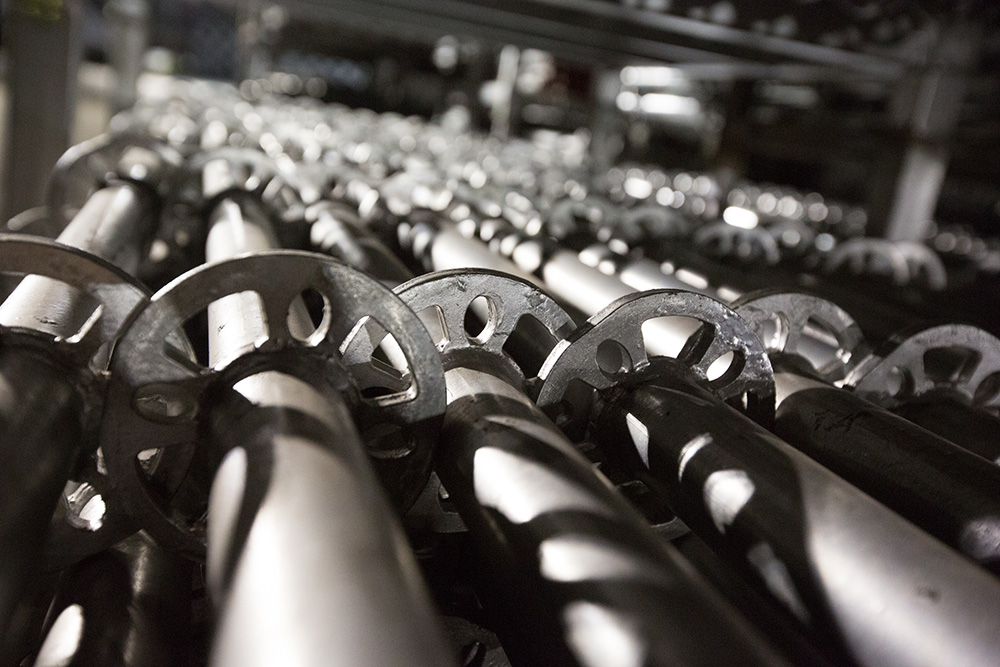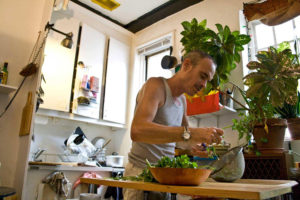It’s Sunday night at EDC Las Vegas. In seven hours, the Vegas sun will reheat the currently 70-degree, slightly humid, and breezy air into a crawling summer swelter. I’m standing in the “boneyard” on the Las Vegas Motor Speedway, fenced in behind the neonGARDEN stage. Lasers paint the desert sky above, while bass reverberates through the air; and though hundreds of thousands of Headliners surround me, all I can see are trailers, industrial-sized forklifts, golf carts, and various other large vehicles and pallets. This impressive display of heavy machinery—and the way it’s all lined up with military precision—begins to shed light on the logistical efforts required to pull off this Super Bowl-sized carnival.
At the helm of the boneyard—and the Site Ops team that runs it—is 26-year-old Derek Finner. He started with Insomniac as a stagehand about six years ago after he jumped in to help at a show. He hasn’t jumped out since.
Site Ops’ mission is to ensure the storyboard version of the festival comes to fruition, as the Speedway gets transformed into the largest music and arts festival in North America. Finner and company oversee everything coming onto the grounds—from the 18-wheelers full of steel scaffolding for the stages to the countless cases of drinking water—and ensure everything gets delivered as planned and executed as smoothly as possible. Though nearly invisible to the public, they play an invaluable part in Insomniac’s operations and success.
The 25-person team has been living on the Speedway for the past 2.5 weeks, with one more to go. Before Las Vegas, they were in New York; the next stop is EDC London. Their bloodshot eyes reveal just how much sleep they haven’t gotten. Site Ops’ Road to EDC is a continuous string of exhausting festival dates. Like that of the Headliners, it involves detailed plans made up to a year in advance.

But no amount of large-scale event preparation can prevent a detail or two from falling through the cracks. The team responds to a mind-numbing 1,500 calls in 24 hours, so being able to adapt to what’s in front of them is critical. “Today’s issues are rarely tomorrow’s,” Finner points out. Like when the massive daisy art installation broke at the kineticFIELD minutes before the show, or when hundreds of pounds of crash barricade had to be torn down and reassembled, or when the wind blew every single fence line down just before showtime.
I’m like a little kid in a candy store when it comes to this music. It’s nice to have found something that I still get excited about each day.
That unpredictability is one of the job’s few constants. “If there’s a question you can’t figure out, call us, and we’ll figure it out for you. If there’s a problem, come to us, and we’ll handle it—or get somebody on it that will,” says Finner. “That’s basically what we do.”
Finner’s simple trailer—his temporary home on the Speedway—is far from fancy, but it feels like a slice of air-conditioned bliss. The first thing you notice when you walk through the door is the massage chair in the corner. The second is that the walls are constantly vibrating due to the low-end frequencies from the bassPOD stage. I imagine this renders sleep nearly impossible. Then again, after “pushing through your third and fourth wind to the point where you’re going to fall over because you’ve been awake and working for 47-hours straight,” as Finner describes it, a bed of nails would probably suffice. “Falling behind isn’t an option.”
Originally from Indiana, Finner moved to Los Angeles after graduating college. As with most Los Angeles transplants, home no longer had anything to offer. As a drum & bass DJ (The Fallen) and co-owner of multiple record labels, he needed to be someplace where things were happening. “I wanted to be among other people that have the same interests, and I just did not have that in the Midwest.
“I honestly couldn’t ask for anything more,” Finner continues, smiling and pointing toward bassPOD. “All these artists that I’ve wanted to be involved with—I look at them on the stage and think, that’s something I helped create. That’s what I always wanted to do. I’m like a little kid in a candy store when it comes to this music. It’s nice to have found something that I still get excited about each day.”
The whole team seems to share that excitement. “The guys will look at me halfway through the build, and we’re all just dragging and want to fall over, and they’re like, ‘Man, this party is going to be insane,’” shares Finner. “They’re pushing to make something that’s never been done before.” Mostly musicians themselves, members of the Site Ops crew, can even occasionally be seen DJing Insomniac stages. Finner notes that it’s like having stock options in the company, giving them all even more pride in their work. “It’s nice to see them be able to have a little bit of the benefit from all the hard work that they’ve done.”
Though humble, Finner exudes the assured swagger of a self-starter who has it more together than most people his age. He is quick to credit his upbringing for these traits, but he also points out that his family really has no understanding of what he does. “My mom has always been interested in what I do and has wanted to see it, whereas my father—he just doesn’t get it. He’s a backwoods redneck; he doesn’t understand the music. I’ll show him videos of me DJing or something, and he’ll be like [changes voice to an old-man tone], ‘Oh, that’s great, but I still don’t understand what you’re doing or what the hype is.’ At the same time, he sees photos of events like this and goes, ‘Well, there must be a little bit of a following for it if this is one of the largest music festivals in the world.’”
As the last Headliners exit the Speedway on Monday morning, the most challenging part of Site Ops’ job is just beginning. In what Finner describes as a “free-for-all,” a week’s worth of setup must be disassembled in just a few days, as his team gets pulled in a hundred different directions by people who want nothing more than to get out, go home and lie down in their own beds.
EDC has come a long way since its early days—a few thousand people attended the event at Los Angeles’ Shrine Expo Hall in 1997, while more than 130,000 filled the Speedway each of three days in 2014. I ask Finner what he thinks 2015 will be like—could he fathom Insomniac one-upping themselves? “I honestly don’t foresee how it could possibly get any better. And the thing is, I know it will.”
The article was for Insomniac.




